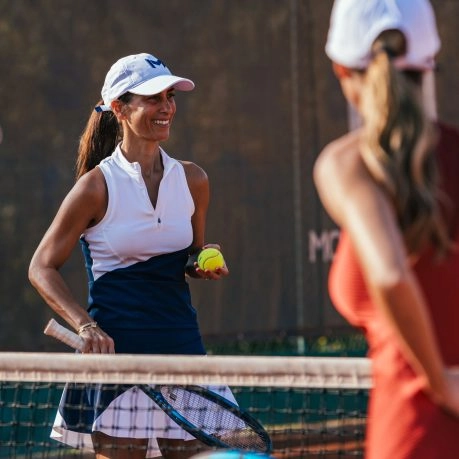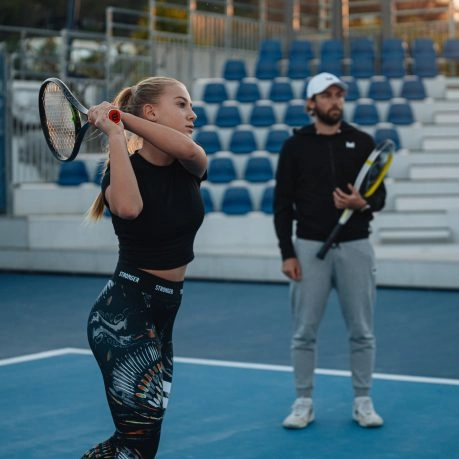
The serve is one ofthe most important shotsin tennis. It is the only moment when the player has total control over the start of the point, making it a powerful strategic weapon. Whether you’re a beginner or an advanced player, understanding the starting position of the tennis serve is essential to maximising the power, accuracy and consistency of your serve. In this article, we’ll take a look at the starting position, the technique to follow and answer the most frequently asked questions about the tennis serve. Transform your serve with the tennis study designed using the Mouratoglou Methodology.
Where to place a tennis serve
The starting position is crucial to the correct execution of the movement. Before serving, position yourself behind the baseline, in the area corresponding to the side you are serving from. If you are serving the first ball, you should stand on the right-hand side of the court and aim for your opponent’s diagonal service area. If you’re serving the second ball, stand on the left-hand side of the court, still aiming for the opposite diagonal.
If you are right-handed, your left foot should be slightly forward, pointing towards your opponent’s service line. The right foot should be slightly behind, at an angle to allow the body to rotate smoothly on impact. If you are left-handed, reverse these positions.

Here is a summary of the starting position:
- Left foot forward for a right-hander (reverse if you are left-handed)
- Right foot placed behind, slightly turned towards the net
- The racket in your right hand (or left for left-handers), ready for action
- Your left arm holds the ball, ready to throw.
The hammer grip for efficient service

The grip of the racket is an essential part of a successful tennis game. The hammer grip is generally the most recommended. This technique gives you good control of the ball while maximising power and spin. With this grip, the racket is held in such a way that your hand is in the same position as if you were holding a hammer.
This grip allows great flexibility in choosing the type of serve: chopped, lifted or flat. It is therefore very useful for both beginners and advanced players.
Throwing the ball: a fundamental movement

This is undoubtedly one of the most critical aspects of the tennis serve. If it’s poorly executed, it becomes almost impossible to deliver a good serve. Here are the keys to a good serve:
- Left arm straight: The arm holding the ball (generally the left arm for right-handed players) must remain straight during the throw.
- Throw high and accurately: The ball should be thrown high enough to allow the player to fully extend his arm at the moment of impact. The gesture must also be stable, so that the ball always lands in the same place.
- Vertical line: Ideally, the ball should be thrown in a vertical line, directly above your head, to maximise accuracy and power.
The armed position and body preparation

The cocked position is when the body and racket are ready to hit the ball. If you are well prepared, your strokes will be more fluid and your shots more effective. Here are the steps:
- Throwing the ball: As soon as the ball is thrown, the racket comes down behind the body.
- Body rotation: The body begins to rotate, with the shoulders turned slightly towards the net.
- Raising the racket: The racket rises, ready to hit the ball, with the opposite arm pointing upwards to maintain balance.
The arm holding the racket should remain relaxed but ready to spring into action to generate good power. By turning the shoulders and leaning on the back leg, the player can generate more speed at impact.
Striking and movement tracking

When hitting the ball, the racket should strike the target at the top of the throw. To maximise power, it’s important to use the rotation of the body and racket together. Here are the key points:
- Contact with the ball: The shot should be made when the ball is at the highest point of the throw. Your arm should be fully extended, with the wrist slightly relaxed to facilitate the movement.
- Follow-through: After the shot, your arm should follow the direction of the target, and your body should continue its forward movement to finish in balance.
For an effective serve, it’s crucial to follow through and not block the movement after impact.
Frequently asked questions (FAQ)
-
In a tennis match, the rules stipulate that the player must serve behind the baseline, without crossing it until the ball has been hit. The player has two attempts.
The serve always starts on the right-hand side for the first point, aiming for the opponent’s diagonal service area. For the next point, the player moves to the other side of the court and so on. -
Several muscle groups are involved. Here are the ones that are used the most:
- Shoulders and arms: The arm and shoulder muscles are the most commonly used, particularly for throwing and hitting the ball.
- Abdominals and back : These muscles are used to maintain balance and to rotate the body during the movement.
- Legs: The leg muscles, particularly the quadriceps and calves, are used to produce power for the first stroke.
-
To improve your game of tennis, it’s important to work on your technique, but also to understand the sequence of the different phases of the game. Here are a few tips:
- Practise your ball throw: A precise, regular stroke will help you improve your serve.
- Work on body rotation: Rotating your shoulders and hips is essential for generating power.
- Use the hammer grip : This grip is the most effective for hitting the target accurately and for varying spin.


















